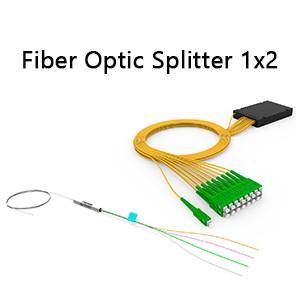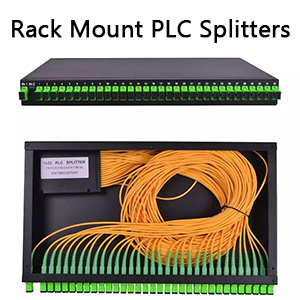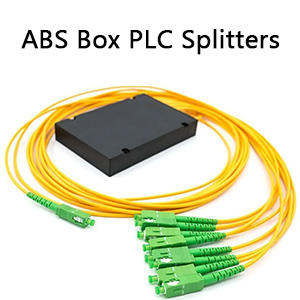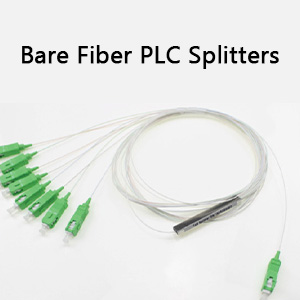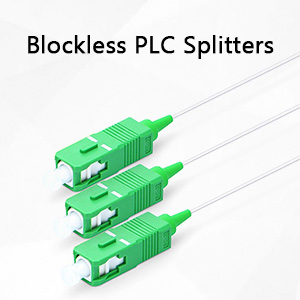Introduction of optical switches
An optical switch is a device for optical path switching. In fiber optic transmission systems, optical switches are used for multiple monitors, LANs, multiple light sources, detectors, and for the protection of Ethernet conversions. In fiber optic testing systems, they are used for fiber optic, fiber optic equipment testing, and network testing, as well as for multi-point monitoring systems in fiber optic sensing.
Background of optical switches
The advent and development of fiber optic communication technology have brought revolutionary changes to the communication industry. Currently, about 85% of the world’s communication business is transmitted via fiber optics, and long-haul backbone networks and local relay networks have widely adopted fiber optics. Especially in recent years, the explosive growth of Internet business based on IP has not only changed the relationship between the IP network layer and the underlying transmission network but also put forward new requirements for the entire network’s architecture, node design, management, and control. An intelligent network system structure—Automatic Switched Optical Networks (ASON) has become a hot topic of research today. Its core nodes are composed of Optical Cross-connect (OXC) devices, which can achieve dynamic wavelength selection and flexible, effective management of the optical network through OXC. OXC technology is one of the key technologies in the increasingly complex DWDM network, and the optical switch, as a functional device for switching optical paths, is a key part of OXC. The optical switch matrix is the core part of OXC, which can achieve dynamic optical path management, fault protection of the optical network, and dynamic wavelength allocation, etc., and is of great significance for solving the current complex network’s wavelength contention, improving wavelength reuse rate, and flexible network configuration. As the optical transmission network develops towards ultra-high speed and ultra-large capacity, the survivability of the network, the protection switching, and recovery issues have become key issues of the network, and the optical switch plays a more important role in the protection switching at the optical layer for the protection and recovery of services.
Application of Optical Switches
The optical switch (Optical Switch, OS) is a device with one or more selectable transmission windows that can perform mutual conversion or logical operations on optical signals in optical transmission lines or integrated optical paths. The basic form of an optical switch is 2×2, with two fibers at both the input and output ends, capable of completing two connection states: parallel connection and cross connection, as shown in Figure 2. Larger space-division optical switching units can be constructed by cascading and combining basic 2×2 optical switches and corresponding 1×2 optical switches.

Optical switches play a very important role in optical networks. In Wavelength Division Multiplexing (WDM) transmission systems, optical switches can be used for wavelength adaptation, regeneration, and clock extraction. In Optical Time Division Multiplex (OTDM) systems, optical switches can be used for demultiplexing. In all-optical switching systems, optical switches are key devices for Optical Cross-connect (OXC) and are also important devices for wavelength conversion. According to the number of input and output ports of the optical switch, they can be divided into 1×1, 1×2, 1xN, 2×2, 2xN, MxN, and so on, each with different uses in different occasions. The main application areas include: optical network protection switching systems, light source control in fiber optic testing, real-time monitoring systems for network performance, testing of optical devices, building the core of OXC equipment switching, optical add/drop multiplexing, optical testing, optical sensing systems, etc.
Main Types of Optical Switches Research
Based on different principles of optical switches, there are various implementation methods for optical switches, such as: traditional mechanical optical switches, micro-mechanical optical switches, thermo-optic switches, liquid crystal optical switches, electro-optic switches, and acousto-optic switches. Among them, traditional mechanical optical switches, micro-mechanical optical switches, and thermo-optic switches are widely used in different occasions due to their respective characteristics.
At present, the most widely used are still the traditional 1×2 and 2×2 mechanical optical switches. Traditional mechanical optical switches can directly couple light to the output end by moving the fiber, using prisms, mirrors to switch the optical path, and directly send or reflect light to the output end.
There are mainly three types of mechanical optical switches: one is the use of prism switching technology for the optical path, the second is the use of mirror switching technology, and the third is switching the optical path by moving the fiber. The basic structure of the moving prism optical switch is shown in Figure 4.
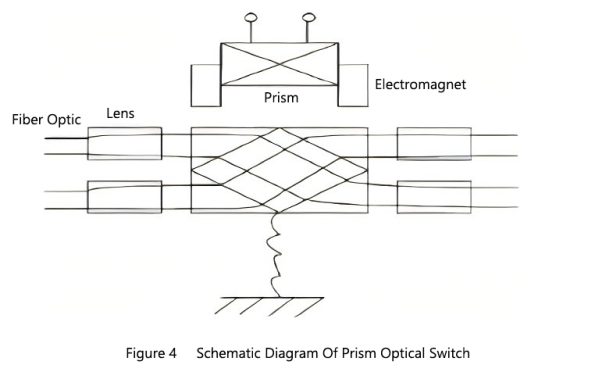
The fiber is connected to the lens that plays a collimating role (collimator) and is fixed in place, and the optical path between the input and output ports is changed by moving the prism. The working principle of the mirror-type optical switch is shown in Figure 3.
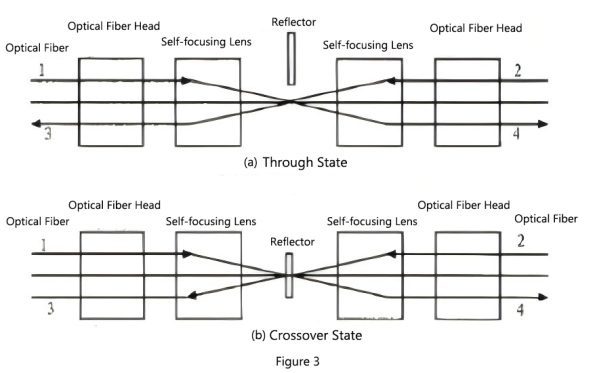
When the mirror is not in the optical path, the optical switch is in the direct pass state, the light entering fiber 1 enters fiber 4, and the light entering fiber 2 enters fiber 3; when the mirror is at the intersection of the two light paths, the optical switch is in the cross state, the light entering fiber 1 enters fiber 3, and the light entering fiber 2 enters fiber 4, thereby achieving the switching of the optical path. The moving fiber-type optical switch is shown in Figure 5, which is to fix one end of the fiber and move the other end of the fiber to couple with different ports of the fixed fiber, achieving the switching of the optical path. This type of optical switch has low return loss and is greatly affected by the ambient temperature, and has not formed a truly commercialized product. The commercialized optical switches in China are mainly moving prism and mirror types.
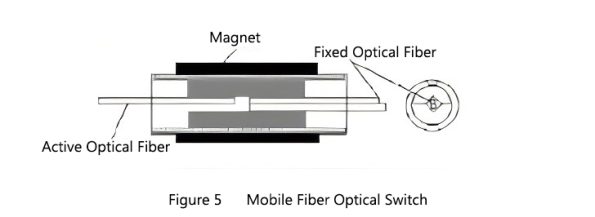
The advantages of mechanical optical switches are low insertion loss (<1dB), high isolation (>45dB), and independence from wavelength and polarization, with mature manufacturing technology. The disadvantages are that the switch action time is relatively long (ms level), the volume is relatively large, and it is not easy to make a large-scale optical switch matrix, sometimes there are issues of rebound jitter and poor repeatability. Mechanical optical switches have been widely used in recent years, but with the continuous expansion of the scale of optical networks, this type of switch is difficult to adapt to the future development needs of high-speed, large-capacity optical transmission networks.
Micro-Electro-Mechanical Systems Optical Switches
In recent years, the development of Micro-Electro-Mechanical Systems (MEMS) optical switches has been rapid. It is a new type of micro-computer-electro-optical integrated switch produced by the combination of semiconductor micro-machining technology, micro-optics, and micro-mechanics, and is the mainstream direction for the development of large-capacity switching optical network switches.
MEMS optical switches are made by etching several tiny mirrors on a silicon wafer. Through the action of static electricity or electromagnetic force, the movable micro-mirrors can rise, rotate, or move, thereby changing the propagation direction of the input light to achieve the function of light path switching. MEMS optical switches have obvious advantages over other optical switches: the switching time is generally in the ms order; they use IC manufacturing technology, with small volume and high integration; the working mode is independent of the format, protocol, wavelength, transmission direction, polarization direction, and modulation mode of the optical signal, and can handle any wavelength of optical signals; at the same time, they have the advantages of mechanical optical switches such as low insertion loss, low crosstalk, low polarization sensitivity, high extinction ratio, and the advantages of waveguide switches such as high switching speed, small volume, and easy large-scale integration.
According to the method of functional implementation, MEMS optical switches can be divided into light path blocking type, moving fiber docking type, and micro-mirror reflection type. The micro-mirror reflection type MEMS optical switch is convenient for integration and control, easy to form an optical switch array, and is a key point in MEMS optical switch research, which can be divided into two-dimensional MEMS optical switches and three-dimensional MEMS optical switches, and the concept of one-dimensional MEMS optical switches has been proposed. The so-called 2D refers to the movable micro-mirror and the fiber being on the same plane, and the movable micro-mirror is either in the open state or the closed state at any given moment. In this way, the movable micro-mirror array is connected with N input fibers and M output fibers. For an N×N optical switch matrix, the number of movable micro-mirrors required is N². Therefore, this method is also called the N² structure scheme.

